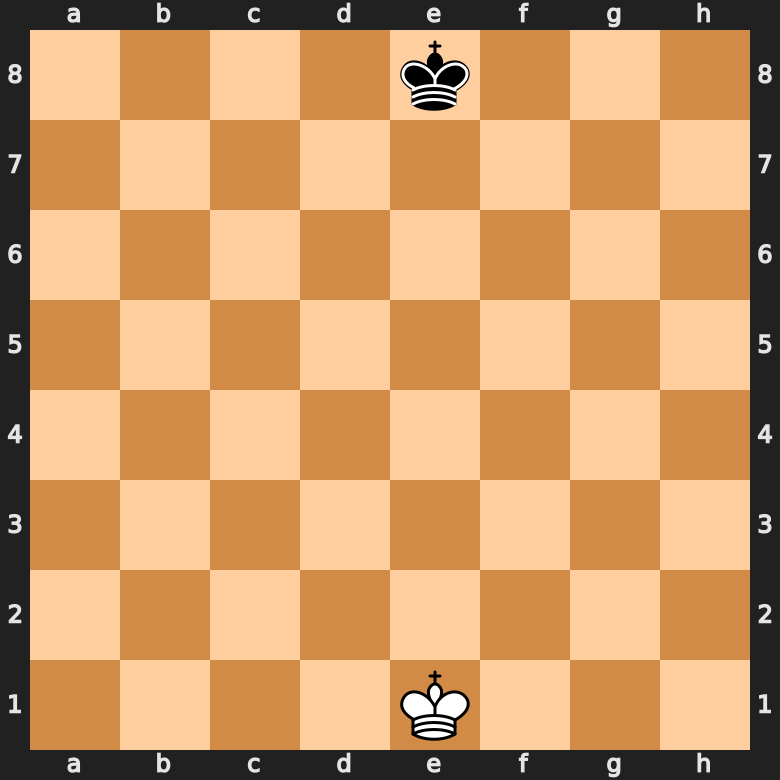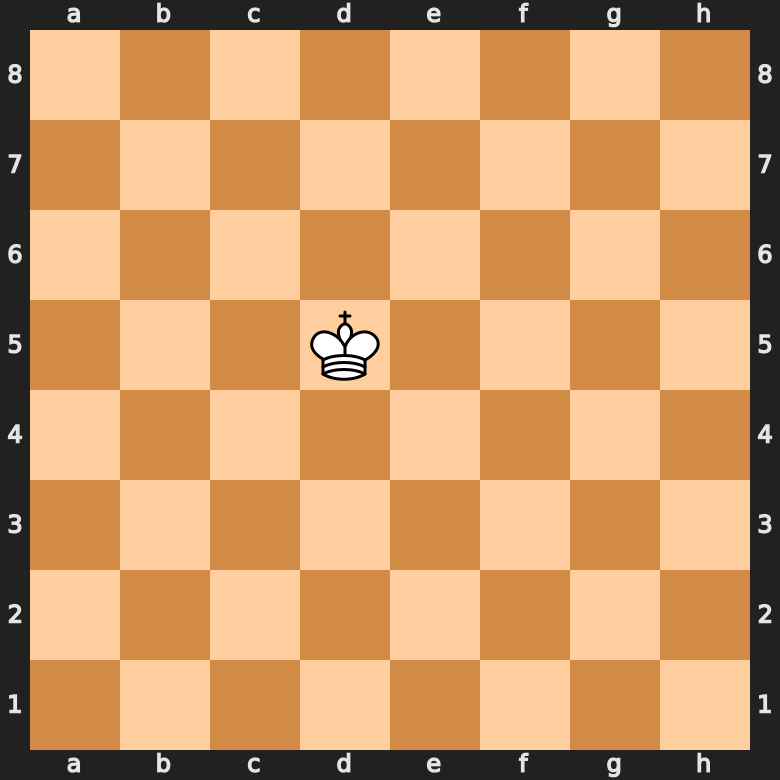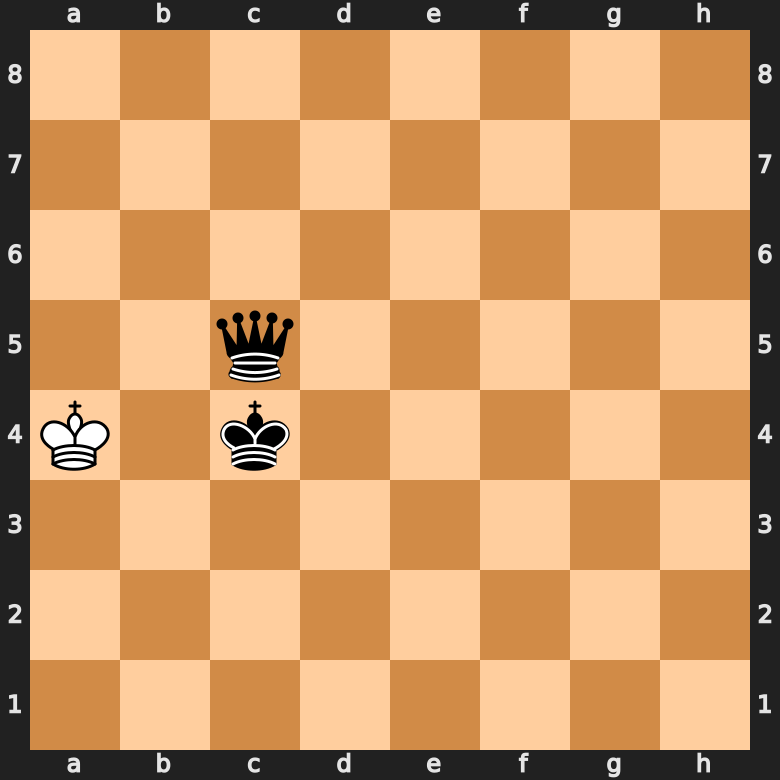The King in Chess ♔: Everything You Need to Know
The king is the most important piece in chess. “Lose” your king and you’ll lose the game. But despite its importance, the king has a very limited ability to move. Thus, the #1 priority in chess is to protect your king from enemy attacks. Let’s take a closer look at how exactly the king moves and what makes him special 👀.
Position of the King on the Board
The white king starts the game on the e1 square, while the black king starts on the e8 square:

Make sure that the white king is on a dark square, while the black king is on a light square. If they’re not, you probably made a mistake setting up the board. We have a detailed guide on how to properly set up a chess board on our website.
In the starting position the king is surrounded by pawns, his queen, and a bishop.
Movement of the King in Chess
The king is not a very strong piece regarding movement 🐢. He can only move one square vertically, horizontally or diagonally at a time, meaning he can only reach squares that are directly next to his current one:

There are a few limitations, in which case a reachable square can not be stepped onto by the king:
- If the square is occupied by a friendly piece
- If the square is occupied by a defended enemy piece
- If the square is being attacked by an enemy piece (that move would put the king in check)
The king can, however, capture pieces as long as they are not defended.
Since the king can only move one square at a time, he has no way of jumping over other pieces (unlike the knight). Even though the king is quite limited in his movement, he will become increasingly strong in the endgame, as other pieces leave the board.
Special Rules for the King
The king is without a doubt the most complex chess piece. So let’s look at some things that make him special compared to other pieces.
Value of the King
Traditionally, we measure the value of a chess piece in the amounts of pawns they are worth. However, since the game is lost whenever the king is “captured” (i. e. checkmated), we don’t assign the king a certain value. He is invaluable 👑.
Checking the King
An important concept in chess is that of attacking the king, otherwise known as “checking the king”. Basically, check is a condition in which the king is under threat of being captured in the opponent’s next move.
There are three ways of getting out a check:
- Moving the king: A check can be defended by simply moving the king to an adjacent square where he is not in check anymore.
- Blocking the check: Moving a piece between the king and the attacking piece blocks the check and thus defends the king.
- Capture the checking piece: By eliminating the attacking piece, the check can also be defended.
If the check cannot be defended by any of these three measures, the game ends with a checkmate ❌.
Checkmate
A checkmate happens whenever a king is in check (i. e. under threat of being captured in the opponent’s next move) and there is no possible escape. The player that gets checkmated loses the game.
Stalemate
Besides the checkmate, there is another way a game of chess can end (let’s ignore technicalities like running out of time or agreeing to a draw for now). If a player has no legal move but his king is not in check, the game is declared a stalemate, meaning it ends in a draw. That usually happens in the endgame, where one player might only have a king left. If the other player is not careful, he can easily rob the king of legal moves without checking him:

Stalemates usually happen when one player has a significant material advantage. That makes it all the more infuriating for the player that made the mistake. No matter the position, a stalemate is always a draw 🤝.
Castling
The king does have one last trick up his sleeve; castling. We have an in-depth guide on castling on our website, so we’ll keep it brief here.
Castling is a move in which a player moves the king two squares towards a rook and the rook “jumps over” the king, placing it directly next to the king. Sounds confusing? 😵 Don’t worry, it sounds way more complicated than it is. Have a look at this:

As you can see, the move itself is not that complicated. Just remember: Two steps for the king and the rook gets placed directly next to it (always jumping over the king!). The king can castle with both rooks, meaning there are two different kinds of castling:
- King-side castling (or a short castle – seen in the animation above)
- Queen-side castling (or a long castle)
The latter happens whenever the king castles with the rook that is closer to the queen (in case of White that would be the rook on a1).
There are four requirements that need to be met for a player to be allowed to castle:
- The king and rook have not yet been moved in the game.
- The king is not in check before and immediately after castling
- The king will not move through a check during castling
- All squares between the rook and king are empty
3 Tips for Using the King
- Protect Your King Early, By Castling Together With The Rook
- Avoid Moving the Pawns in Front of Your King
- Use Your King in the Endgame
King – Frequently Asked Questions
- How Does the King Move in Chess?The king can move one square in any direction – vertically, horizontally or diagonally.
- How Many Spaces Can the King Move in Chess?The king can only move one square at a time.
- What Does A King Look Like In Chess?The king is the tallest piece in chess. You can also identify the king by the cross on his head.
- Can A King Take A Queen In Chess?Yes, theoretically the king can take a queen in chess. That would however require a blunder by the opponent, as the king can't approach the queen without putting himself into check (which would be an illegal move).
- Can A King Still Castle After Its Been In Check?Yes, the king can still castle after it has been in check. However, it is not allowed to castle while the king is in check or the king would be passing through a check.
- Can a King Put a King in Check?No, that is not possible. For a king to check another king, it would move itself into check, which is not allowed.
- Why is the King so Weak in Chess?As in real-life, the king on its own is usually quite weak, commanding his army from the safety of a castle. But in chess the most probable reason why the king is comparetively weak, is the fact that it shouldn't be too hard to checkmate.

